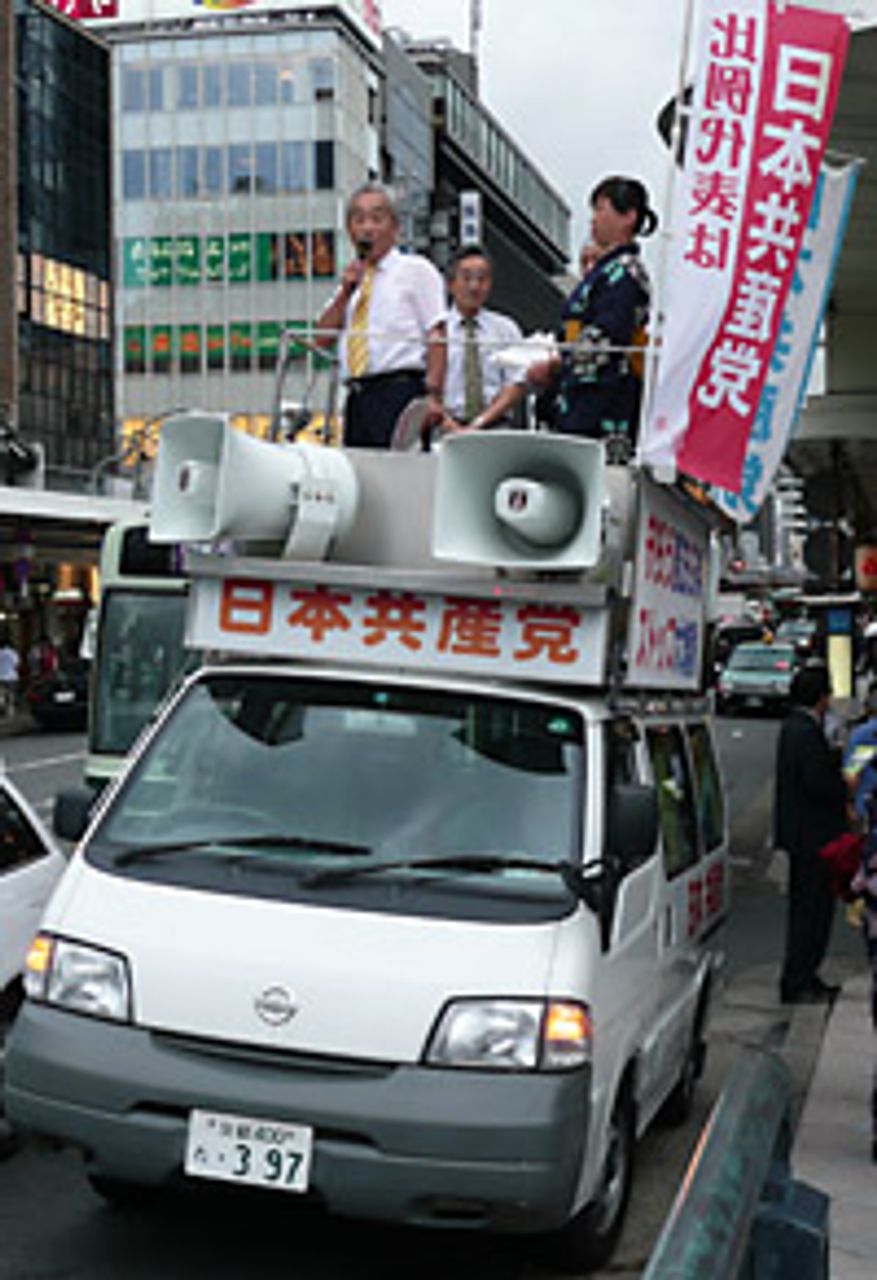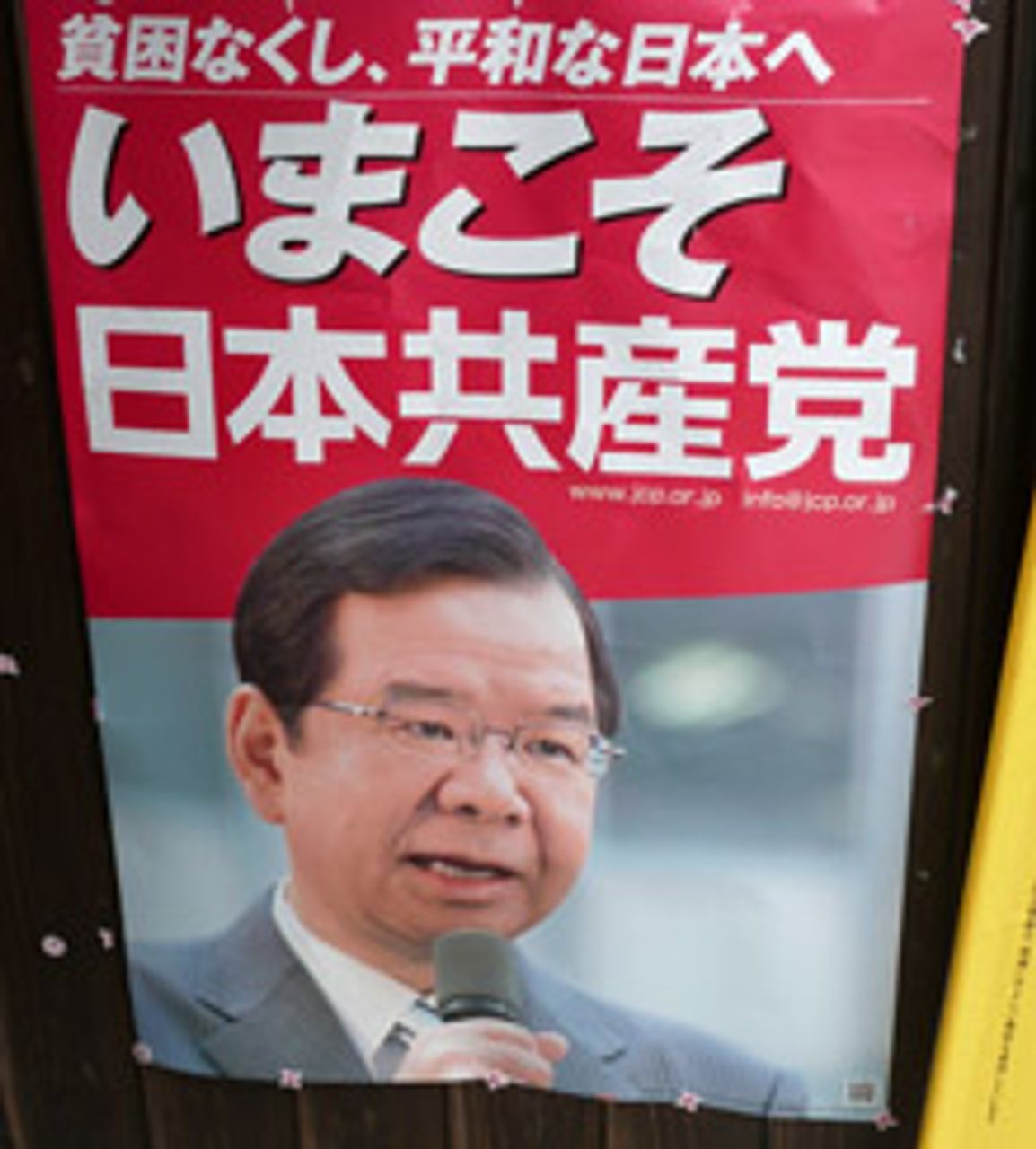One aspect of the parliamentary elections to be held in Japan on Sunday is the role of the Japanese Communist Party (JCP). With all the opinion polls pointing to a decisive victory of the opposition Democratic Party of Japan over the incumbent Liberal Democratic Party, the JCP appears to be the only smaller party likely to pick up votes and possibly seats.
 JCP campaigning in Kyoto
JCP campaigning in KyotoAt a critical turning point in Japanese politics, the Communist Party is positioning itself as a safety valve for the political establishment by corralling popular discontent with the two major parties behind a perspective that in no way challenges the capitalist system. While the party still calls itself “communist” and makes vague references to “socialism”, its election platform consists of limited promises to safeguard workers, farmers and small businesses through protectionist measures and a return to national economic regulation.
The JCP’s foreign policy calls for greater independence from the US, including an end to Japan’s Cold War security treaty with the US and the presence of American military bases on Japanese soil. For all its anti-imperialist posturing and pacifist phrase-mongering, the party’s program lines up with sections of the Japanese ruling class who are deeply frustrated at having to play second fiddle to Washington and want a more aggressive foreign policy to assert Japan’s own economic and strategic interests.
There is no doubt that the current election is creating considerable nervousness in Japanese ruling circles. If, as expected, the Liberal Democrats are ousted, Japanese politics will be entering uncharted waters. With the exception of a brief interlude in 1993, the right-wing party has been in power since it was formed in 1955. The opposition Democratic Party, which was only formed in 1998 as an alliance of Liberal Democratic breakaway factions and ex-members of the Socialist Party, has never held the reins of government.
The surge of support for the Democrats reflects profound hostility toward the government over deepening social inequality, growing unemployment and deteriorating living standards. The global economic recession has battered Japanese exports and the economy as a whole. Last month unemployment hit a six-year high and the labour ministry forecast that as many as 290,000 part-time and temporary contract workers could lose their jobs by September. Indices of poverty, homelessness and social inequality are all on the rise.
The Democratic Party, however, is incapable of addressing the needs of working people. Like the ruling Liberal Democrats, the party is committed to pro-market reform, which, under conditions of ongoing economic crisis, will mean making further deep inroads into the social position of the working class. The Democratic Party has already pledged to slash the country’s huge public debt, which currently stands at 170 percent of GDP. That cannot be done simply by ending “waste and corruption”, as the Democrats claim, but will require the gutting of public spending, particularly social services.
Despite the Democratic Party’s large lead in the polls, there is considerable suspicion and distrust that it will not carry out its election pledges. Young people in particular are looking for political alternatives. Many have been forced into poorly paid, part-time and temporary work by the steady undermining of the country’s lifelong employment system over the past two decades. If the Democratic Party does win the election, it will inevitably confront growing disillusion and opposition as the gulf between popular expectations and reality becomes evident.
 JCP leader Kazuo Shii
JCP leader Kazuo ShiiThat is precisely why the Communists are being cultivated as a mechanism to defuse social and political tensions. Like its counterparts in Europe, the Communist Party in Japan has long been part of the political establishment. In the current election campaign, it was one of six parties invited to participate in TV debates. In a recent interview, party leader Kazuo Shii boasted that he had been invited onto a major commercial TV station and encouraged to present his bowdlerised version of Marxism.
Commentators in Japan and internationally have noted a growing interest in socialism, especially among young people. A manga [comic] version of Marx’s masterpiece Capital has become a best seller. A classic pre-war novel Kanikosen, highlighting the brutal exploitation of workers on a crab canning boat, sold more than half a million copies last year and another 200,000 in a comic version.
The Communist Party appears to have benefitted. According to Shii, party membership has been growing by 1,000 per month since September 2007 and has reached 415,000 members. Many of the new members are young people in their 20s and 30s. Currently, the party holds nine seats in the 480-seat lower house. It is clearly hoping to expand its 7 percent share of the vote and its parliamentary presence.
The Communist Party has made clear that it is ready to work with a government led by the Democrats. The party’s election manifesto declared that its aim was to end Liberal Democratic rule and “choose a new direction for Japanese politics”. In comments to the media last week, Shii somewhat reluctantly ruled out a formal coalition with the Democrats, saying there were too many areas of disagreement and “we have not received an invitation”.
At the same time, however, Shii was quick to emphasise that in areas of agreement his party would offer its full support to the new government. The party would function as a “constructive opposition”, he declared. In advance, Shii is offering his services to help contain the popular opposition that will inevitably emerge.
No one who is familiar with the Japanese Communist Party’s history and program should be in the least surprised by its willingness to collaborate with an openly bourgeois party. The party was founded in 1922 on the basis of socialist internationalism by workers and intellectuals inspired by the Russian Revolution but those political foundations were destroyed by the rise of the Stalinist bureaucracy in the Soviet Union.
The Communist Party rapidly adopted the reactionary Stalinist perspective of “socialism in one country” and its corollary—the two-stage theory. While opposing Japanese imperialism and the rise of militarism in the 1930s, the party insisted that the working class had to support “progressive” sections of the national bourgeoisie in carrying out national, democratic reforms. The second stage—the struggle for socialism—was postponed indefinitely to the distant future.
This program was to have devastating consequences following World War II as the working class sought to put an end to the hardships, injustice and repression of Japan’s militarist regime. Based on its record of opposition, the Communist Party grew rapidly from a small, hunted, underground organisation to a mass party with millions of members. But far from seeking to put an end to bourgeois rule, it played the key role in helping to restabilise Japanese capitalism.
The key turning point came in 1947 as a mass movement built up and a general strike was imminent. In an effort to shore up the government, the head of the US occupation, General Douglas MacArthur, banned the strike. Rather than challenge the order, the Communists meekly complied, absurdly insisting, in line with their two-stage theory, that the American occupation represented the first democratic stage of the Japanese Revolution.
Having countered the threat, the US, as part of its international Cold War counteroffensive against “communism”, banned the Communist Party in 1949 and launched a “Red Purge” of anyone suspected of socialist sympathies in the state bureaucracy. The party was legalised again in the 1950s after the signing of the US-Japan Security Treaty in 1952 that ended the occupation. From then, the party, like its Stalinist counterparts in Western Europe, loosened its ties with Moscow and Beijing and fully integrated itself into the political establishment in Japan.
For decades, the Communist Party played second fiddle to the reformist Japanese Socialist Party and indeed played a similar tune: it publicly eschewed socialist revolution insisting that the lot of workers could be improved via piecemeal parliamentary reform and trade union militancy. The decades-long rule of the Liberal Democrats ensured that the Socialists and the Communists remained in opposition. The Socialists joined a grand coalition with the Liberal Democratic Party in 1994—a decision that completely discredited the party and produced a political implosion.
While the Communist Party, to date, has managed to avoid a similar fate, that is primarily because it has never been tested in power. Its perspective, which is thoroughly rooted in nationalism, is diametrically opposed to the socialist internationalism of Marxism. The party’s 2004 program is based on economic protectionism as a palliative for small businesses and farmers, a modest list of social reforms and the strident demand that Japanese capitalism must end its subservience to the US, including the military alliance and presence of US bases.
The Communist Party today distances itself from “the historic and colossal evil of Soviet hegemonism” and blames the collapse of the Soviet Union on the fact that “Stalin and other successive Soviet leaders discarded the principles of socialism”. However, the party is organically incapable of dealing honestly with its own record of support for Stalin’s monstrous crimes and remains completely hostile to the international Trotskyist movement, which fought the betrayals of the Stalinist bureaucracy.
The Communist Party and its supporters would no doubt vehemently object to being described as “Stalinist”. Yet the party is still based on the Stalinist perspective of “socialism in one country” and the two-stage theory. Its program openly declares that what Japanese society “needs at present is a democratic revolution instead of a socialist one” and declares that its proposals for democratic reforms are “realisable within the framework of capitalism”. The socialist stage, it states, “will be a long process that needs a stage-by-stage progress based on national consensus”—certainly socialist revolution is ruled out.
All of this is a pledge to the political establishment that the Communist Party will devote its energies in the coming period to propping up Japanese capitalism. Workers and youth in Japan looking for a genuine socialist alternative need to begin a serious study of the lessons of the strategic experiences of the international working class in the course of the twentieth century, especially the protracted and difficult struggle waged by the Trotskyist movement against Stalinism and all forms of national opportunism.
The International Committee of the Fourth International is the leadership of the world party of socialist revolution, founded by Leon Trotsky in 1938.
